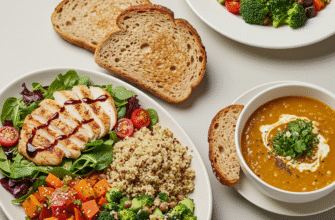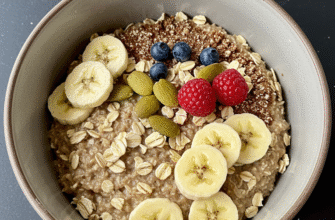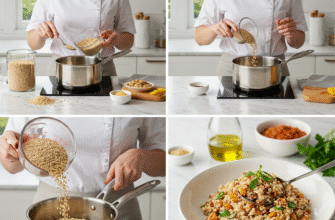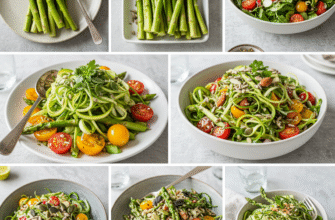Often relegated to a mere sprinkle on top, scallions, or green onions as many call them, deserve so much more attention in the kitchen. These slender alliums pack a surprising punch of fresh, oniony flavour without the overwhelming intensity of their bulbous cousins. They bridge the gap between onion and herb, offering both aromatic depth and bright, grassy notes. More than just a garnish, scallions are incredibly versatile and can be transformed into starring ingredients with just a little know-how. Let’s explore some genuinely tasty and wholesome ways to bring these green gems to the forefront of your meals.
First, understanding the anatomy helps. The white and light green part near the root has a more pronounced, pungent onion flavour, similar to a mild onion or shallot. It holds up well to cooking. The darker green tops are more tender and herbaceous, with a milder taste. These are often best used fresh or added towards the end of cooking to preserve their delicate flavour and vibrant colour. Don’t discard either part – they both have wonderful uses!
Embracing the Raw Power
One of the simplest and most impactful ways to use scallions is raw. Their crisp texture and zesty bite can elevate countless dishes.
Salads and Slaws
Thinly sliced scallions, both white and green parts, are fantastic in salads. They add a subtle heat and complexity that complements leafy greens, crunchy vegetables, and creamy dressings. Try them in a simple cucumber salad with a sesame-ginger vinaigrette, or toss them into a potato salad for a fresh counterpoint to the richness. In slaws, they cut through the creaminess of mayonnaise-based dressings or add zip to vinegar-based versions.
The Ultimate Garnish
Okay, yes, garnishing is a common use, but let’s do it with intention! Instead of a haphazard sprinkle, think about how the scallion enhances the dish. Finely chopped green tops add colour and freshness to soups (like miso or hot and sour), noodle dishes, tacos, omelettes, and baked potatoes. Slicing them thinly on the bias (diagonally) creates elegant, longer pieces that look beautiful and distribute flavour well. For an extra flourish, you can create scallion curls by slicing the green tops into very thin lengthwise strips and plunging them into ice water. They’ll curl up beautifully, adding visual appeal to canapés or plated dishes.
Dips and Spreads
Finely minced scallions, especially the white parts, are brilliant in dips and spreads. Mix them into cream cheese with a little garlic powder for a simple bagel spread. Fold them into Greek yogurt with lemon juice and dill for a refreshing vegetable dip. Blend them into hummus or white bean dip for an extra layer of flavour. The key is to chop them finely so their flavour disperses evenly.
Turning Up the Heat: Cooked Scallion Sensations
Cooking scallions mellows their flavour, bringing out a subtle sweetness while retaining their characteristic oniony essence.
Stir-Fries: A Fundamental Flavour
Scallions are a cornerstone of many Asian stir-fries. Typically, the white parts are sliced and added early in the cooking process along with garlic and ginger to form the aromatic base. They release their fragrance into the hot oil, flavouring everything that follows. The green tops are often added right at the end, just before serving, to maintain their colour and provide a fresh finish. Try cutting the white parts into 1-inch segments for more presence in the final dish.
Grilling and Roasting: Smoky Sweetness
This is where scallions truly transform. Grilling or roasting whole scallions brings out an incredible smoky sweetness. Toss them lightly in olive oil, salt, and pepper.
For Grilling: Place them directly on the grill grates perpendicular to the bars over medium heat. Grill for a few minutes per side until tender and nicely charred. They become wonderfully floppy and intensely flavourful.
For Roasting: Spread them on a baking sheet and roast at around 400°F (200°C) for 10-15 minutes, flipping once, until softened and slightly caramelized at the edges. Grilled or roasted scallions are amazing served alongside grilled meats, fish, or tofu, or chopped and folded into grain salads or pasta dishes.
Verified Tip: For perfectly grilled scallions, avoid overly high heat which can burn the delicate greens before the whites soften. Medium heat allows them to cook through evenly. You can also bundle them together and tie with kitchen twine for easier handling on the grill.
Scallion Pancakes: A Savory Delight
A beloved classic in Chinese and Korean cuisine, scallion pancakes are crispy, chewy, and packed with flavour. These are essentially simple doughs rolled thin, generously sprinkled with chopped scallions (use plenty!), often a touch of oil or fat, then rolled up and coiled before being flattened again and pan-fried. The layering technique creates flaky pockets interspersed with savoury scallion flavour. Served with a simple soy-vinegar dipping sauce, they are utterly addictive.
Infusing Soups and Broths
While often used as a garnish, scallions can also build flavour within soups and broths. Add chopped white parts along with other aromatics at the beginning stages of making stock or soup. For a clearer broth where you want a distinct but not overpowering onion flavour, you can even add whole scallions (perhaps tied in a bundle with herbs for easy removal) during simmering. This imparts a gentler flavour than using regular onions.
Scallion Oil: Liquid Gold
Creating scallion oil is a fantastic way to capture their essence. Gently heat a neutral oil (like grapeseed or canola) in a saucepan over low heat. Add a generous amount of chopped scallions (mostly green parts work well here, but whites add depth too). Let them sizzle very gently – you don’t want them to brown quickly or burn – for about 15-20 minutes, or until they become fragrant and slightly crispy. Strain the oil and store it in the refrigerator. This intensely flavoured oil is incredible drizzled over noodles, rice, vegetables, eggs, or used as a base for vinaigrettes.
Selecting and Storing Your Scallions
Look for scallions with bright green, fresh-looking tops that aren’t wilted or slimy. The white parts should be firm and clean. Avoid any that look limp or yellowed. For storage, the best method is often debated, but a popular technique involves trimming any damaged tips, then standing the scallions upright in a jar with about an inch of water covering the roots, like a bouquet of flowers. Cover loosely with a plastic bag and store in the refrigerator. This keeps them hydrated and crisp for longer than just storing them in the vegetable drawer.
Alternatively, you can wrap the scallions (with roots trimmed slightly if overly long) in a barely damp paper towel and place them inside a plastic bag or airtight container in the crisper drawer. This also works well for a week or more.
Regrowing Scallions: A Sustainable Trick
Don’t throw away those white root ends! You can easily regrow scallions. Simply place the white ends (with roots attached, about an inch long) in a small glass with enough water to cover the roots. Place it on a sunny windowsill. Change the water every couple of days. Within a few days, you’ll see new green shoots emerging. You can snip off the green parts as needed, and they’ll continue to regrow several times, giving you a continuous supply of fresh green tops!
Scallions are far more than just a pretty face on your plate. Their versatility, ranging from sharp and raw to sweet and charred, makes them an indispensable ingredient. By exploring different preparations and utilizing both the white and green parts, you can unlock a world of flavour and add a healthy, vibrant touch to your everyday cooking. So next time you’re at the store, grab an extra bunch and start experimenting!
“`







